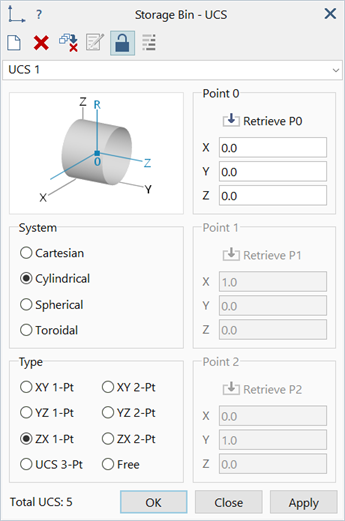Global: Define Cylindrical UCS

Description
Defines a cylindrical coordinate system (UCS) (see Global: Define UCS).
Cylindrical coordinate systems use the coordinates R, T and Z (radius, theta and Z) to define the position of a point. R and Z are distances, whereas T is an angle.
A rotation about the Z axis of the cylindrical UCS, using the right-hand rule, defines the direction of positive T.
Dialog
Type
Method used to position and orientate the cylindrical UCS.
-
XY / YZ / ZX 1-Pt
A single point (Point 0) defines a cylindrical UCS on one of the global Cartesian planes (XY-plane, YZ-plane or ZX-plane).
The origin is located at Point 0.
The Z axis is perpendicular to the selected plane.
The R axis at T=0 is parallel to the first axis on the selected plane (i.e., the global X, Y or Z axis respectively).
Point 1 and Point 2 are implicitly defined.
-
XY / YZ / ZX 2-Pt
Two points (Point 0 and Point 2) define a cylindrical UCS on one of the global Cartesian planes (XY-plane, YZ-plane or ZX-plane).
The origin is located at Point 0.
The Z axis is perpendicular to the selected plane.
The R axis at T=0 lies on the selected plane and is generally directed from Point 0 to Point 2.
Point 1 is implicitly defined.
-
UCS 3-Pt
Three points (Point 0, Point 1 and Point 2) define an arbitrarily orientated cylindrical UCS.
The origin is located at Point 0.
The Z axis is directed from Point 0 to Point 1.
The R axis at T=0 lies on the plane defined by the three points, is perpendicular to the Z axis, and is generally directed from the origin towards Point 2.
The T direction is a positive rotation about the Z axis using the right-hand rule.
-
Free
Three points (Point 0, Point 1 and Point 2) define the arc of a circle in 3D space.
The origin is located at the centre of the circle.
The Z axis is perpendicular to the plane defined by the three points, passing through the centre of the circle.
The R axis is perpendicular to the Z axis, and generally directed from the origin towards Point 0.
Point 0 / Point 1 / Point 2
Three points used to position and orientate a cylindrical UCS.
Coordinates of points may be retrieved from the model by clicking a node, vertex or grid point, or by explicitly typing the values into the edit boxes.
See Also